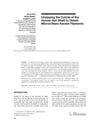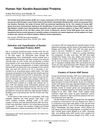TLDR Circle hairs are harmless, spiral-shaped body hairs that don't need medical treatment.
This document described a case of circle hairs (CHs) in a 20-year-old female, which was unusual as CHs were typically observed in elderly, hairy, and obese males. CHs were characterized by asymptomatic, circular or spiral hair growth beneath the stratum corneum, without follicular or inflammatory abnormalities. The exact cause of CHs was unknown, but they were considered a benign, genetically predetermined disorder possibly linked to vestigial mammal undercoats. The case highlighted the use of trichoscopy for diagnosis and noted that CHs needed differentiation from rolled hairs, which were associated with follicular hyperkeratosis and inflammation. Treatment options included plucking or laser ablation, although regrowth was possible.
20 citations
,
October 1996 in “Journal of the American Academy of Dermatology”
37 citations
,
October 2015 in “PeerJ” Perming significantly changes hair's molecular structure, while shampoo and conditioner do not.
107 citations
,
October 2014 in “PeerJ” Hair's molecular structure is mostly consistent, but genetic differences affect lipid types, which could help diagnose diseases.
55 citations
,
January 2013 in “International Journal of Cosmetic Science” African hair's keratin structure is influenced by its higher lipid content.
52 citations
,
April 2012 in “Journal of Investigative Dermatology” KRTAP2 genes are crucial for hair structure and may impact hair disorders and treatments.
22 citations
,
January 2010 in “Clinical Medicine Insights Endocrinology and Diabetes” Forearm hair has more cortisol than lower leg hair.
 7 citations
,
August 2006 in “Biopolymers”
7 citations
,
August 2006 in “Biopolymers” Researchers extracted tiny keratin filaments from human hair by unzipping its outer layer.
 71 citations
,
August 2005 in “The journal of investigative dermatology. Symposium proceedings/The Journal of investigative dermatology symposium proceedings”
71 citations
,
August 2005 in “The journal of investigative dermatology. Symposium proceedings/The Journal of investigative dermatology symposium proceedings” Hair keratin-associated proteins are essential for strong hair, with over 80 genes showing specific patterns and variations among people.
12 citations
,
January 1934 in “Proceedings of the Royal Society of London Series B Containing Papers of a Biological Character” Stretched hair has a similar structure to natural silk, showing hair's elasticity involves reversible changes within its molecules.


